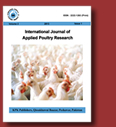|
|
|
|
|
|
|
|
Phytochemical composition and insecticidal effect of
essential oil from Origanum
vulgare L.
|
|
Tunay Karan1* and Seyda Simsek2 |
|
1Plant Research Laboratory, Department of Molecular
Biology and Genetic, Faculty of Arts and Sciences, Gaziosmanpasa
University, 60240 Tokat, Turkey; 2Department of Plant
Protection, Faculty of Agriculture, Bozok University, Yozgat, Turkey
|
|
| Abstract |
|
Origanum
genus belonging to Lamiaceae family has been used extensively throughout
the world. Air-dried aerial part of
Origanum vulgare L. was
subjected to steam distillation to yield the essential oil of which the
compounds were elucidated by GC-MS analysis. The main constituents of
essential oil were determined as thymol (40.35%),
p-cymene (17.32%), γ-terpinene
(15.66%), and carvacrol (12.15%). The insecticidal activity of essential
oil was executed against
Sitophilus oryzae (L.) (Coleoptera: Curculionidae) and
Rhyzopertha dominica (F.) (Coleoptera:
Bostrychidae) by fumigation method. It was presented that the essential
oil was highly effective against both species. After treatment of
essential oil on S. oryzae,
72% and 88% mortality were observed at 48 hours (h) and 72 h
respectively. The mortality of R.
dominica was determined as 94% and 96% at 48 h and 72 h
respectively. Median lethal concentration (LC50) values were
found for S. oryzae as 0.086
µL /mL
and 0.057 µL /mL at 24 h and 48 h respectively. Moreover, these
values (LC50) were presented as 0.11 µL /mL and 0.065 µL /mL
at 24 h and 48 h respectively for
R. dominica. Hence, the essential oil of
O. vulgare could be useful for
the managing field populations of
S. oryzae and R. dominica.
|
|
Keywords:
Origanum vulgare;
essential oil; insecticidal activity |
| |
| To cite this article:
Karan T and S Simsek, 2018.
Phytochemical composition
and insecticidal effect of essential oil from
Origanum vulgare L..
Res.
Opin. Anim. Vet. Sci., 8(1): 19-23. |
|
|

